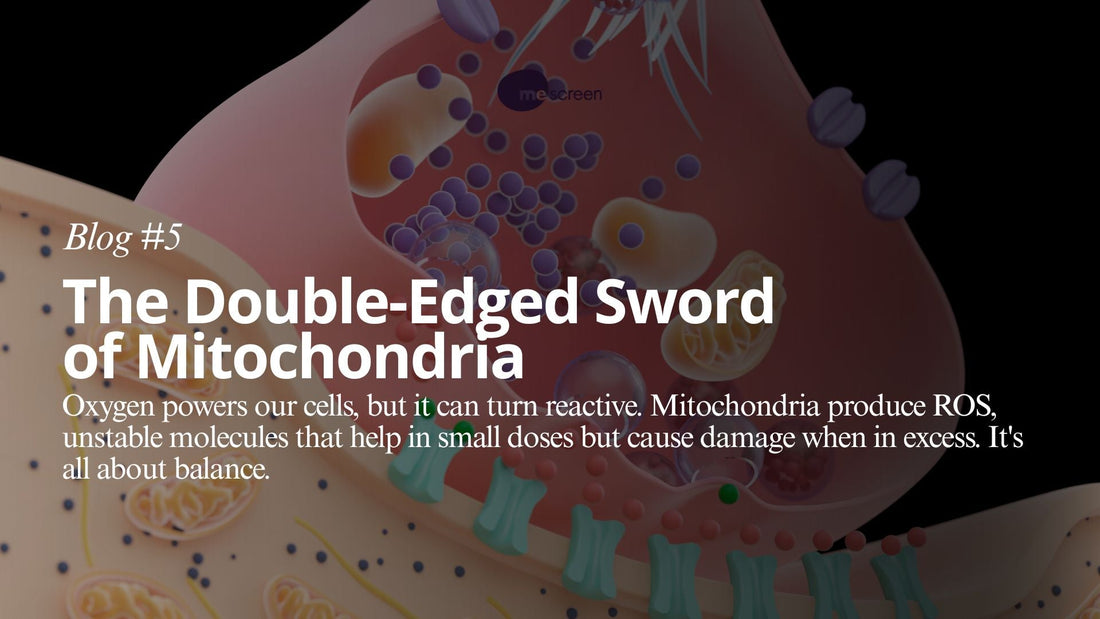Understanding Mitochondrial Health: A Weekly Learning Series
🧪 They Create Reactive Oxygen Species (ROS): The Double-Edged Sword of Mitochondria
When we hear the word “oxygen,” most of us think of something good, something vital. We breathe it in, our blood carries it, and our cells use it to create energy. But what happens when oxygen gets a little too reactive?
Enter reactive oxygen species (ROS), tiny, unstable molecules produced as a byproduct of mitochondrial energy production. While ROS are often painted as the villains in health conversations, the truth is more nuanced.
ROS aren’t inherently bad — in fact, your body needs them in small amounts. But too much ROS can lead to oxidative stress, damaging your cells and speeding up aging and disease.
Let’s explore how mitochondria create ROS, why it matters, and how this delicate balance influences your health.
⚙️ What Are Reactive Oxygen Species (ROS)?
ROS are chemically reactive molecules that contain oxygen. Some common types include:
- Superoxide anion (O₂⁻)
- Hydrogen peroxide (H₂O₂)
- Hydroxyl radical (•OH)
These molecules are highly unstable and can damage DNA, proteins, and lipids if not properly managed. But they’re also part of your body’s normal cell signaling and defense systems.
▶ Controlled Hypoxia for Mitochondria Control (Mitophagy enhancer)
🔋 Mitochondria: Energy Powerhouses, and ROS Factories
Inside your mitochondria, oxidative phosphorylation is the process that creates ATP, the cell’s energy currency. This process involves moving electrons through a chain of protein complexes (the electron transport chain). But sometimes, electrons escape this chain and react with oxygen prematurely. This produces ROS.
- Some ROS production is normal.
- Too much ROS = oxidative stress = damage.
This means mitochondria are both:
- ✅ Essential energy producers
- ❌ Unintentional sources of stress when unregulated
🧬 Why Your Body Needs Some ROS
Although too much ROS is harmful, low to moderate levels are necessary for normal cellular function. ROS help:
- Signal cells to grow, divide, or die
- Support immune system defenses by killing pathogens
- Activate antioxidant defenses and detox enzymes
- Facilitate memory and learning in the brain
In this way, ROS act like a “stress signal,” giving cells a nudge to respond, adapt, or improve resilience.
☣️ When ROS Go Too Far: Oxidative Stress
If mitochondrial ROS production gets out of control, due to stress, toxins, aging, poor diet, or disease, it overwhelms the cell’s antioxidant systems. This creates oxidative stress, which can:
- Damage brain cells → linked to Alzheimer’s & Parkinson’s
- Damage blood vessels → contributes to heart disease
- Damage DNA → increases risk of cancer
- Weaken immune cells → increases infection & inflammation
- Accelerate aging and cell death
Oxidative stress is like rust inside your body, silent, progressive, and harmful over time.
🧪 How Your Body Balances ROS
Your body is smart. It has antioxidant defenses to manage ROS, including:
- Enzymes like superoxide dismutase (SOD), catalase, and glutathione peroxidase
- Antioxidant molecules like glutathione, vitamin C, and vitamin E
- Signaling pathways that activate detox and repair responses
Healthy mitochondria produce just the right amount of ROS. But damaged mitochondria? They leak excessive ROS, triggering a vicious cycle of more damage and dysfunction.
🧠 How to Support Healthy ROS Balance
You don’t need to eliminate ROS, just manage them. Here’s how:
- ✅ Exercise regularly – boosts antioxidant enzymes
- ✅ Eat antioxidant-rich foods – berries, greens, turmeric, omega-3s
- ✅ Avoid excessive toxins – smoking, alcohol, pollution
- ✅ Get quality sleep – supports mitochondrial repair
- ✅ Manage stress – chronic stress increases ROS
- ✅ Consider screening – tools like Mescreen™ can assess your mitochondrial performance and oxidative stress markers
🔬 Final Thought: Mitochondria’s Risky Business
Mitochondria are like tiny power plants inside your cells. They fuel your life, but also generate metabolic smoke in the form of ROS. When the system runs smoothly, that smoke is managed. But if it builds up, it can choke the machinery. Understanding this delicate balance is key to longevity, mental clarity, energy, and resilience.
Take care of your mitochondria, and they’ll take care of you.
📚 References
- Murphy, M. P. (2009). "How mitochondria produce reactive oxygen species." Biochemical Journal, 417(1), 1–13. DOI
- Zorov, D. B., Juhaszova, M., & Sollott, S. J. (2014). "Mitochondrial reactive oxygen species (ROS) and ROS-induced ROS release." Physiological Reviews, 94(3), 909–950. DOI
- Brand, M. D. (2010). "The sites and topology of mitochondrial superoxide production." Experimental Gerontology, 45(7-8), 466–472. DOI
- Sena, L. A., & Chandel, N. S. (2012). "Physiological roles of mitochondrial reactive oxygen species." Molecular Cell, 48(2), 158–167. DOI
- Giorgio, M., Trinei, M., Migliaccio, E., & Pelicci, P. G. (2007). "Hydrogen peroxide: a metabolic by-product or a common mediator of ageing signals?" Nature Reviews Molecular Cell Biology, 8(9), 722–728. DOI
- NIH: MedlinePlus Genetics – Mitochondria

